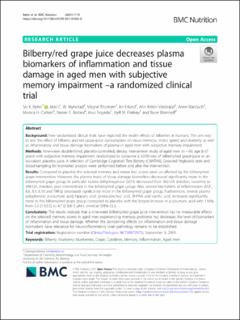| dc.contributor.author | Bøhn, Siv K. | |
| dc.contributor.author | Myhrstad, Mari C. W. | |
| dc.contributor.author | Thoresen, Magne | |
| dc.contributor.author | Erlund, Iris | |
| dc.contributor.author | Vasstrand, Ann Kristin | |
| dc.contributor.author | Marciuch, Anne | |
| dc.contributor.author | Carlsen, Monica H. | |
| dc.contributor.author | Bastani, Nasser E. | |
| dc.contributor.author | Engedal, Knut | |
| dc.contributor.author | Flekkøy, Kjell- Magne | |
| dc.contributor.author | Blomhoff, Rune | |
| dc.date.accessioned | 2022-02-25T15:08:26Z | |
| dc.date.available | 2022-02-25T15:08:26Z | |
| dc.date.created | 2021-12-02T15:38:02Z | |
| dc.date.issued | 2021-11-22 | |
| dc.identifier.citation | BMC Nutrition. 2021, 7 (75), . | en_US |
| dc.identifier.issn | 2055-0928 | |
| dc.identifier.uri | https://hdl.handle.net/11250/2981544 | |
| dc.description.abstract | Background: Few randomized clinical trials have explored the health effects of bilberries in humans. The aim was to test the effect of bilberry and red grape-juice consumption on visual memory, motor speed and dexterity as well as inflammatory and tissue damage biomarkers of plasma in aged men with subjective memory impairment.
Methods: Nine-week double-blind, placebo-controlled, dietary intervention study of aged men (n = 60, age ≥ 67 years) with subjective memory impairment randomized to consume a 50/50 mix of bilberry/red grape-juice or an iso-caloric placebo juice. A selection of Cambridge Cognition Test Battery (CANTAB), Grooved Pegboard tests and blood-sampling for biomarker analysis were performed before and after the intervention.
Results: Compared to placebo the selected memory and motor test scores were un-affected by the bilberry/red grape intervention. However, the plasma levels of tissue damage biomarkers decreased significantly more in the bilberry/red grape group. In particular lactate dehydrogenase (LDH) decreased from 362 U/L (median, baseline) to 346 U/L (median, post intervention) in the bilberry/red grape group. Also, several biomarkers of inflammation (EGF, IL6, IL9, IL10 and TNFα) decreased significantly more in the bilberry/red grape group. Furthermore, several plasma polyphenols; p-coumaric acid, hippuric acid, protocatechuic acid, 3HPAA and vanillic acid, increased significantly more in the bilberry/red grape group compared to placebo with the largest increase in p-coumaric acid with 116%; from 2.2 [1.0,5.5] to 4.7 [2.8,8.1] μM/L (median [95% CL]).
Conclusions: The results indicate that a nine-week bilberry/red grape juice intervention has no measurable effects on the selected memory scores in aged men experiencing memory problems but decreases the level of biomarkers of inflammation and tissue damage. Whether the dampening effects on inflammation and tissue damage biomarkers have relevance for neuroinflammatory brain pathology remains to be established. | en_US |
| dc.description.sponsorship | This work was supported by The Throne Holst Foundation, Lions club of Norway, The Research Council of Norway and The Norwegian Cancer Society. | en_US |
| dc.language.iso | eng | en_US |
| dc.publisher | BMC | en_US |
| dc.relation.ispartofseries | BMC Nutrition;7, Article number: 75 (2021) | |
| dc.rights | Navngivelse 4.0 Internasjonal | * |
| dc.rights.uri | http://creativecommons.org/licenses/by/4.0/deed.no | * |
| dc.subject | Bilberries | en_US |
| dc.subject | Blueberries | en_US |
| dc.subject | Grapes | en_US |
| dc.subject | Cytokines | en_US |
| dc.subject | Memory | en_US |
| dc.subject | Inflammation | en_US |
| dc.subject | Aged men | en_US |
| dc.title | Bilberry/red grape juice decreases plasma biomarkers of inflammation and tissue damage in aged men with subjective memory impairment –a randomized clinical trial | en_US |
| dc.type | Peer reviewed | en_US |
| dc.type | Journal article | en_US |
| dc.description.version | publishedVersion | en_US |
| dc.rights.holder | © The Author(s). 2021 | en_US |
| dc.source.articlenumber | 75 | en_US |
| cristin.ispublished | true | |
| cristin.fulltext | original | |
| cristin.qualitycode | 1 | |
| dc.identifier.doi | https://doi.org/10.1186/s40795-021-00482-8 | |
| dc.identifier.cristin | 1963649 | |
| dc.source.journal | BMC Nutrition | en_US |
| dc.source.volume | 7 | en_US |
| dc.source.pagenumber | 17 | en_US |

